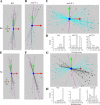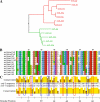Specific roles for the GATA transcription factors end-1 and end-3 during C. elegans E-lineage development
- PMID: 21854766
- PMCID: PMC4454387
- DOI: 10.1016/j.ydbio.2011.08.002
Specific roles for the GATA transcription factors end-1 and end-3 during C. elegans E-lineage development
Abstract
end-1 and end-3 are GATA transcription factors important for specifying endoderm cell fate in Caenorhabditis elegans. Deletion of both factors together results in larval arrest, 0% survival and a fate change in the endoderm-specifying E lineage. Individual deletions of either factor, however, result in the development of viable, fertile adults, with 100% of worms developing to adults for end-1(-) and 95% for end-3(-). We sought to quantify the variable phenotypes seen in both deletions using automated cell lineaging. We quantified defects in cell lifetime, cell movement and division axis in end-3(-) embryos, while quantifying perturbations in downstream reporter gene expression in strains with homozygous deletions for either gene, showing that each deletion leads to a unique profile of downstream perturbations in gene expression and cellular phenotypes with a high correlation between early and late defects. Combining observations in both cellular and gene expression defects we found that misaligned divisions at the E2 stage resulted in ectopic expression of the Notch target ref-1 in end-3(-) embryos. Using a maximum likelihood phylogenetic approach we found end-1 and end-3 split to form two distinct clades within the Caenorhabditis lineage with distinct DNA-binding structures. These results indicate that end-1 and end-3 have each evolved into genes with unique functions during endoderm development, that end-3(-) embryos have a delay in the onset of E lineage cell fate and that end-1 has only a partially penetrant ability to activate E lineage fate.
Copyright © 2011. Published by Elsevier Inc.
Figures







Similar articles
-
Genetic redundancy in endoderm specification within the genus Caenorhabditis.Dev Biol. 2005 Aug 15;284(2):509-22. doi: 10.1016/j.ydbio.2005.05.016. Dev Biol. 2005. PMID: 15979606
-
Partially compromised specification causes stochastic effects on gut development in C. elegans.Dev Biol. 2017 Jul 1;427(1):49-60. doi: 10.1016/j.ydbio.2017.05.007. Epub 2017 May 11. Dev Biol. 2017. PMID: 28502614
-
The function and regulation of the GATA factor ELT-2 in the C. elegans endoderm.Development. 2016 Feb 1;143(3):483-91. doi: 10.1242/dev.130914. Epub 2015 Dec 23. Development. 2016. PMID: 26700680 Free PMC article.
-
The Caenorhabditis elegans intestine.Wiley Interdiscip Rev Dev Biol. 2013 May-Jun;2(3):347-67. doi: 10.1002/wdev.93. Epub 2012 Oct 9. Wiley Interdiscip Rev Dev Biol. 2013. PMID: 23799580 Review.
-
GATA factors as key regulatory molecules in the development of Drosophila endoderm.Dev Growth Differ. 2005 Dec;47(9):581-9. doi: 10.1111/j.1440-169X.2005.00836.x. Dev Growth Differ. 2005. PMID: 16316403 Review.
Cited by
-
Evolutionary Dynamics of the SKN-1 → MED → END-1,3 Regulatory Gene Cascade in Caenorhabditis Endoderm Specification.G3 (Bethesda). 2020 Jan 7;10(1):333-356. doi: 10.1534/g3.119.400724. G3 (Bethesda). 2020. PMID: 31740453 Free PMC article.
-
Uncoupling different characteristics of the C. elegans E lineage from differentiation of intestinal markers.PLoS One. 2014 Sep 2;9(9):e106309. doi: 10.1371/journal.pone.0106309. eCollection 2014. PLoS One. 2014. PMID: 25181289 Free PMC article.
-
Timing of Tissue-specific Cell Division Requires a Differential Onset of Zygotic Transcription during Metazoan Embryogenesis.J Biol Chem. 2016 Jun 10;291(24):12501-12513. doi: 10.1074/jbc.M115.705426. Epub 2016 Apr 7. J Biol Chem. 2016. PMID: 27056332 Free PMC article.
-
MED GATA factors promote robust development of the C. elegans endoderm.Dev Biol. 2015 Aug 1;404(1):66-79. doi: 10.1016/j.ydbio.2015.04.025. Epub 2015 May 8. Dev Biol. 2015. PMID: 25959238 Free PMC article.
-
Systems-level quantification of division timing reveals a common genetic architecture controlling asynchrony and fate asymmetry.Mol Syst Biol. 2015 Jun 10;11(6):814. doi: 10.15252/msb.20145857. Mol Syst Biol. 2015. PMID: 26063786 Free PMC article.
References
-
- Altschul S, Gish W, Miller W, Myers E, Lipman D. Basic local alignment search tool. J. Mol. Biol. 1990;215:403–410. - PubMed
-
- Anisimova M, Gascuel O. Approximate likelihood-ratio test for branches: a fast, accurate, and powerful alternative. Syst. Biol. 2006;55:539–552. - PubMed
-
- Baugh LR, Hill AA, Slonim AK, Brown EL, Hunter CP. Composition and dynamics of the Caenorhabditis elegans early embryonic transcriptome. Development. 2003;130(5):889–900. - PubMed
MeSH terms
Substances
Grants and funding
LinkOut - more resources
Full Text Sources
Research Materials
Miscellaneous

